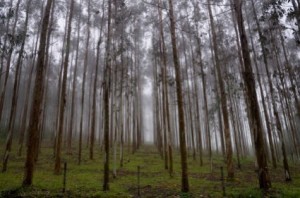On 9 April 2015, the Brazilian Technical Commission on Biosafety (CTNBio) approved the commercial use of genetically engineered eucalyptus trees. This is the first approval of GE trees in Latin America. The application came from FuturaGene, a subsidiary of pulp and paper company, Suzano.
 Paulo Pase de Andrade works in the Laboratory of Molecular Genetics at the Universidade Federal de Pernambuco. Until September 2012, he was a member of CTNBio. The day before CTNBio approved the release of GE eucalyptus, he wrote to theCampaign to STOP GE Trees, explaining that the decision had already been taken – the CTNBio meeting the following day was a technicality.
Paulo Pase de Andrade works in the Laboratory of Molecular Genetics at the Universidade Federal de Pernambuco. Until September 2012, he was a member of CTNBio. The day before CTNBio approved the release of GE eucalyptus, he wrote to theCampaign to STOP GE Trees, explaining that the decision had already been taken – the CTNBio meeting the following day was a technicality.
The CTNBio decision, Andrade explained, was based solely on the biological risks of GE eucalyptus. Andrade also sent a 23-pagerisk assessment (in Portuguese) of GE eucalyptus that he co-authored.
What CTNBio did not consider is that industrial tree plantations have serious social and environmental impacts. GE tree plantations intensify these impacts. Industrial tree plantations take up vast areas of land, land that is often already in use. Faster growing treesneed more water, sucking streams dry and leaving less water for communities living nearby.
In March 2015, a meeting of CTNBio was occupied by 300 peasants from Brazil’s Landless Workers’ Movement (MST). The decision to approve FuturaGene’s GE trees was postponed.
FuturaGene claims that because its GE eucalyptus trees grow faster, they absorb more carbon dioxide. Here’s Stanley Hirsch, FuturaGene’s chief executive, quoted in a 2014 article in Nature News & Comment:
The tree’s speedy growth boosts absorption of carbon dioxide from the air by about 12% … aiding in the fight to reduce greenhouse-gas emissions.
Hirsch’s argument makes no sense, because the trees are clearcut and converted to short-lived paper products, at which point the carbon dioxide returns to the atmosphere.
But does the approval of GE trees in Brazil mean that we can now expect REDD payments to go to companies planting vast monocultures of genetically engineered eucalyptus trees? After all, business as usual would mean planting slower growing non-GE eucalyptus trees that would absorb less carbon dioxide.
As far as I am aware, the issue of GE trees has not been discussed during the UN climate negotiations on REDD. (If anyone knows otherwise, please let me know via the comments.)
Part of REDD, as agreed at the UN climate negotiations in Cancun (COP-16) in 2010, is “Enhancement of forest carbon stocks”.
Instead of REDD, perhaps GE tree plantations would be included in the clean development mechanism’s afforestation/reforestation methodologies. But because there is still no agreed definition of “forest” in the REDD negotiations, plantations (including GE tree plantations) are not explicitly excluded.
Of course, “safeguards” were also agreed in Cancun, including this one:
(e) That actions are consistent with the conservation of natural forests and biological diversity, ensuring that the actions referred to in paragraph 70 of this decision are not used for the conversion of natural forests, but are instead used to incentivize the protection and conservation of natural forests and their ecosystem services, and to enhance other social and environmental benefits;[1]
[1] Taking into account the need for sustainable livelihoods of indigenous peoples and local communities and their interdependence on forests in most countries, reflected in the United Nations Declaration on the Rights of Indigenous Peoples, as well as the International Mother Earth Day.
But as I’ve previously pointed out on REDD-Monitor, the UN only encourages governments to “promote and support” the safeguards. This safeguard translates as follows:
Governments are encouraged to “promote and support” “actions” to conserve forests, biodiversity, and to ensure that REDD does not lead to clearcutting forests in order to replace them with industrial tree plantations.
None of this rules out clearcutting industrial tree plantations (as part of business as usual) and replacing them with industrial tree plantations of genetically engineered trees.
We can look forward to arguments about faster growing GE trees requiring less land to produce the same amount of timber, thus allowing more room for biodiversity and conservation. But given that Suzano plans to expand its pulp production from 1.92 million tons in 2013, to 3.42 million tons by 2015, these arguments don’t stand up. The plantations to feed Suzano’s expanding pulp production will require more and more land.
Clear definitions of “forests”, “deforestation” and “degradation” in the REDD negotiations could exclude the possibility of REDD payments going to monoculture GE tree plantations. But there are still no agreed definitions to differentiate rainforests from monoculture tree plantations (genetically engineered or otherwise) in the UNFCCC REDD negotiations.
